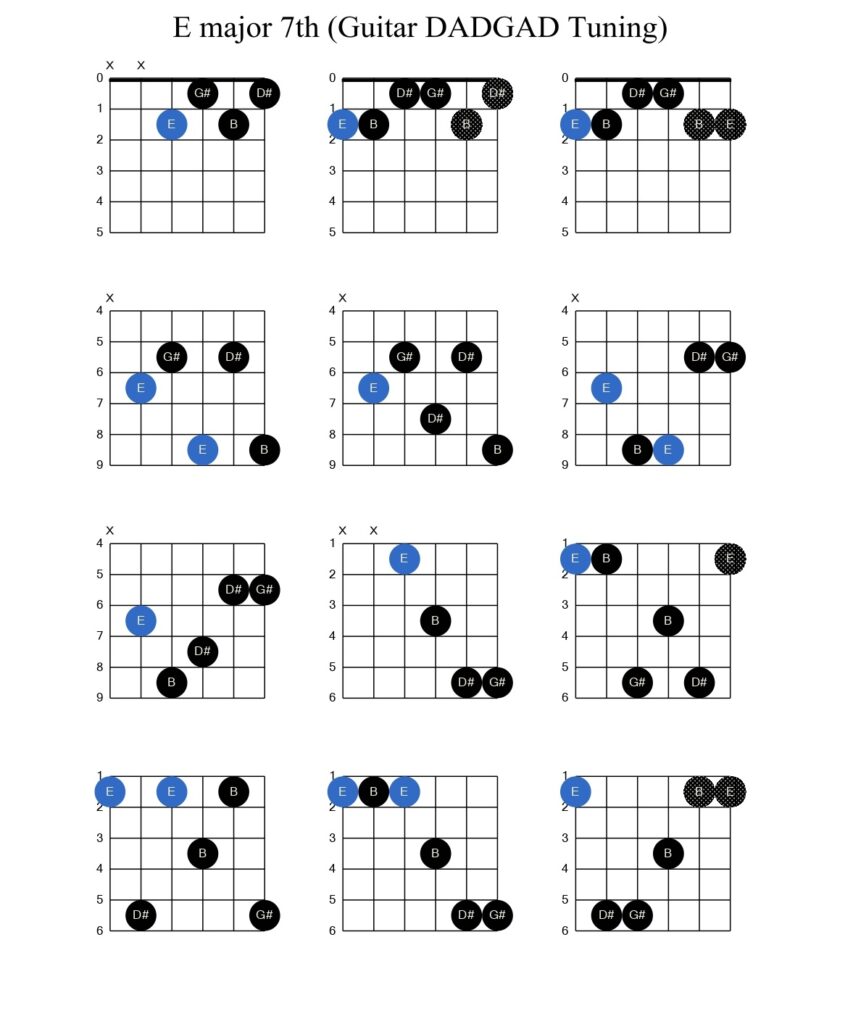If you’re a guitarist looking to expand your chord vocabulary and explore unique tunings, you’re in the right place. In this tutorial, we’ll delve into playing the E Major 7th chord in the DADGAD tuning, a versatile and atmospheric tuning that can add depth and complexity to your sound. We’ll provide step-by-step instructions and a handy chord chart to help you master this beautiful and jazzy chord.
Understanding DADGAD Tuning

Before we dive into playing the E Major 7th chord, let’s briefly understand the DADGAD tuning. Unlike the standard EADGBE tuning, DADGAD has a distinct, open sound that’s perfect for a range of musical styles, from folk to alternative and even jazz. The notes for each string in DADGAD tuning are as follows:
- 6th string (low E): D
- 5th string (A): A
- 4th string (D): D
- 3rd string (G): G
- 2nd string (A): A
- 1st string (high E): D
The unique characteristic of DADGAD is the open D5 power chord, providing a rich and resonant foundation for a variety of chord voicings.
The E Major 7th Chord
The E Major 7th chord (E∆7) is a harmonically rich and sweet-sounding chord that’s often used in jazz, fusion, and other sophisticated musical genres. This chord consists of the following notes:
- E (Root)
- G# (Major 3rd)
- B (Perfect 5th)
- D# (Major 7th)
Now, let’s see how to play the E Major 7th chord in DADGAD tuning.
E Major 7th Chord in DADGAD Tuning
To play the E Major 7th chord in DADGAD tuning, follow these simple steps:
Step 1: Start with an Open D5 Chord
Begin by strumming all the open strings. This will give you a D5 chord, which serves as the foundation for the E Major 7th chord in this tuning.
Step 2: Add Your Fingers
Now, place your fingers on the fretboard to create the E Major 7th chord:
- Place your index finger on the 1st fret of the 2nd string (A).
- Use your middle finger to press down the 2nd fret of the 4th string (D).
You can also use your thumb to lightly touch the 6th string (low E) to mute it, ensuring that only the five strings in the DADGA tuning are heard when you strum the chord.
Step 3: Strum the Chord
Strum all the strings except the 6th string (low E). This will produce a lush and dreamy E Major 7th chord.
Chord Chart
For a visual representation of the E Major 7th chord in DADGAD tuning, here’s a chord chart:
e|---0---
B|---1---
G|-------
D|---2---
A|---0---
D|---0---
Each line in the chart corresponds to a string on the guitar, with the numbers indicating the frets to press and play.
Experiment and Explore
Now that you’ve learned how to play the E Major 7th chord in DADGAD tuning, take some time to experiment and explore. Try incorporating this chord into your compositions or use it as a substitute for E Major 7th in standard tuning to create a unique sonic atmosphere.
Remember that the beauty of DADGAD tuning lies in its versatility, so don’t limit yourself to just one chord. Explore different voicings, progressions, and melodies to truly unlock the potential of this tuning.
the E Major 7th chord in DADGAD tuning is a fascinating addition to your guitar repertoire. Its enchanting sound can transport your music to new and exciting places. So, pick up your guitar and start experimenting with this beautiful and harmonically rich chord today. Happy playing!
- A Wonderful Night Music Tutorial Guitar, Piano, and Ukulele Chord Charts
- Another Love Piano Lessons for Beginners with Chord Chart
- Cmaj 7th Guitar Lesson with Chord Chart
- Bella Ciao EASY Guitar Tutorial With Chords / Lyrics
- Cupid (Twin Version) – FIFTY FIFTY Fingerstyle Guitar TAB, Chords, and Lyrics
Love to learn more about it
My love for the Guitar has been an amazing playing experience. The Guitar never stops teaching you. If you keep practicing and play everyday you will learn how to play chords and progressions and it will start making sense to you. Today I play Guitar with confidence and can play more than a few styles of music and I’m still learning. I am very interested in exploring different ways to tune my guitar and learn the chord shapes and sounds they make.